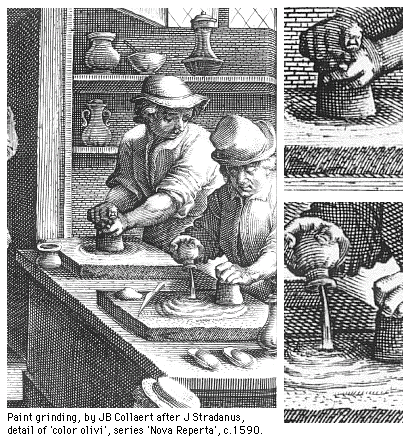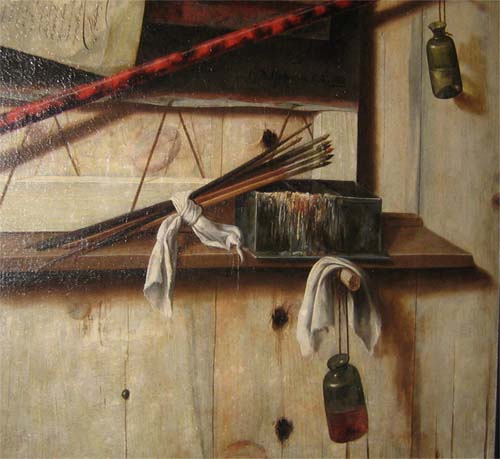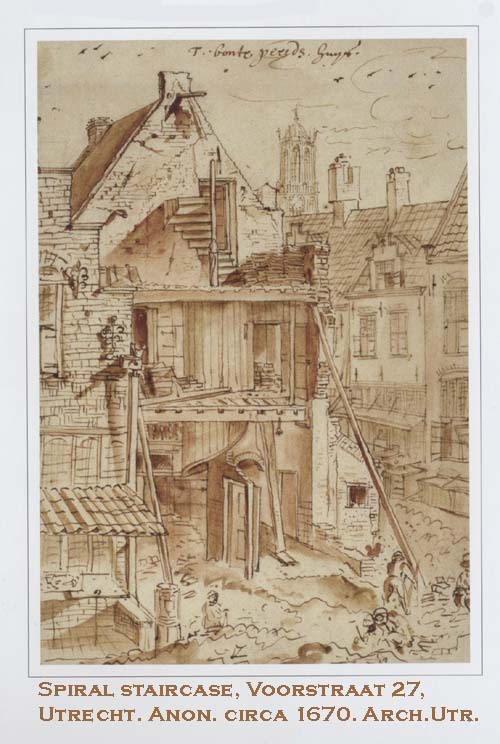A stone table to grind colours on, along with the stone (Stenen tafel om verf te wrijven, met een steen daarbij), Vermeer room N, the attic (de zolder).

Shown above are details of the engraving by Jan Baptist Collaert (1566-1628) after Johannes Stradanus. This engraving shows a complete artist's studio and bears the caption "COLOR OLIVI [=oliui] / Colorem oliui commodum victoribus. Inuenit insignis magister Eyckius." The author Henny thinks the usual stone was porphyry.
Painting above by David III Ryckart, Painters Workshop, 1638. I know of copies in the Louvre Paris and Musée de Beaux-Arts, Dijon.

Above: Detail of a painting showing painters studio gear, a bundle of paint brushes, an open oil tin for cleaning brushes by dipping them in for a longer time. The paint then is released from the brush hairs and slowly sinks to the bottom. The hanging bottles contain a liquid, perhaps a drying agent. Painting by Cornelis Gijsbrechts, coll. Statens Museum for Kunst, Copenhagen.

A spiral staircase led from the Voorhuis (Forehouse) to the upstairs floor and the attic. The drawing above shows a similar spiral staircase in a house located on on Voorstraat 27 in Utrecht.
Note: Illustration from Ernst van de Wetering, Rembrandts studio, p 138. A similar object was listed by the clerk working for Delft notary public J. van Veen. He made this list on February 29, 1676, in the Thins/Vermeer home located on Oude Langendijk on the corner of Molenpoort. The painter Johannes Vermeer had died there at the end of December 1675. His widow Catherina and their eleven children still lived there with her mother Maria Thins.
The transcription of the 1676 inventory, now in the Delft archives, is based upon its first full publication by A.J.J.M. van Peer, "Drie collecties..." in Oud Holland 1957, pp. 98-103. My additions and explanations are added within square brackets [__]. Dutch terms have been checked against the world's largest language dictionary, the Dictionary of the Dutch Language (Woordenboek der Nederlandsche Taal , or WNT), which was begun by De Vries en Te Winkel in 1882.
Henny, Xenia, 'Hoe kwamen de Roterdamse schilders aan hun verf? 't Hemelrijck, leverancier van schildersbenodigdheden' in Nora Schadee ( ed.) Rotterdamse Meesters uit de Gouden Eeuw, Historisch Museum Rotterdam, Waanders, Zwolle, 1994: 43-54.
This page forms part of a large encyclopedic site on Vermeer and Delft. Research by Drs. Kees Kaldenbach (email). A full presentation is on view at johannesvermeer.info.
Launched December, 2002; Last update March 2, 2017.
Back to the Welcome page: click Welcome.